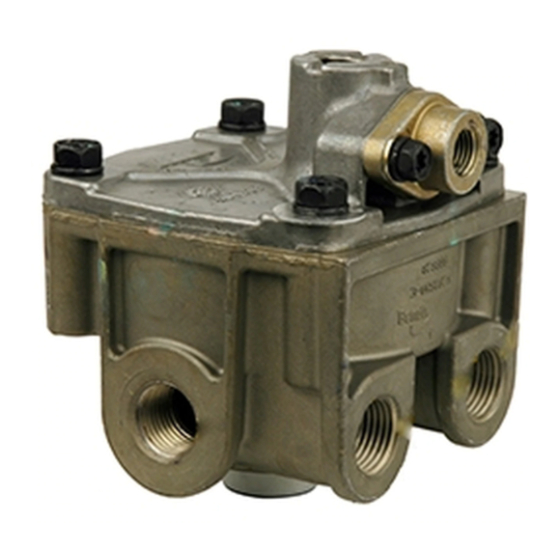BENDIX ATR1DC ANTILOCK TRACTION RELAY Instructions d'installation - Page 2
Parcourez en ligne ou téléchargez le pdf Instructions d'installation pour {nom_de_la_catégorie} BENDIX ATR1DC ANTILOCK TRACTION RELAY. BENDIX ATR1DC ANTILOCK TRACTION RELAY 4 pages. Antilock traction relay valve
Également pour BENDIX ATR1DC ANTILOCK TRACTION RELAY : Manuel (12 pages)

GENERAL SAFETY GUIDELINES
WARNING! PLEASE READ AND FOLLOW
T H E S E I N S T R U C T I O N S T O AV O I D
PERSONAL INJURY OR DEATH:
When working on or around a vehicle, the following
general precautions should be observed at all times.
1. Park the vehicle on a level surface, apply the
parking brakes, and always block the wheels.
Always wear safety glasses.
2. Stop the engine and remove ignition key when
working under or around the vehicle. When
working in the engine compartment, the engine
should be shut off and the ignition key should
be removed. Where circumstances require
that the engine be in operation, EXTREME
CAUTION should be used to prevent personal
injur y resulting from contact with moving,
rotating, leaking, heated or electrically charged
components.
3. Do not attempt to install, remove, disassemble
or assemble a component until you have read
and thoroughly understand the recommended
procedures. Use only the proper tools and
observe all precautions pertaining to use of those
tools.
4. If the work is being performed on the vehicle's
air brake system, or any auxiliary pressurized air
systems, make certain to drain the air pressure
from all reservoirs before beginning ANY work
on the vehicle. If the vehicle is equipped with
an AD-IS
air dryer system or a dryer reservoir
®
module, be sure to drain the purge reservoir.
INSTALLATION OF BENDIX
Bendix approves two methods of installation:
(a) either install the valve onto the vehicle with OEM
approved mounting bolts, and then attach the fittings, or,
(b) bench installation of the fittings, using only the clamp
location shown in Figure 3, before installing the valve on
the vehicle.
1. Clean and inspect all air lines and electrical harnesses
for damage and replace as necessary. Select one of the
two fitting installation methods, either bolt the valve onto
the vehicle first, or clamp, as shown in Figure 3, using a
bench vise.
Bayonet
(Twist-Lock)
Connector
FIGURE 2 ‑ THE BENDIX
BAYONET CONNECTOR
2
AT-3
TRACTION VALVE
®
™
AT-3
SOLENOID VALVE -
®
™
5. F o l l o w i n g t h e v e h i c l e m a n u f a c t u r e r ' s
recommended procedures, deactivate the
electrical system in a manner that safely removes
all electrical power from the vehicle.
6. Never exceed manufacturer's recommended
pressures.
7.
Never connect or disconnect a hose or line
containing pressure; it may whip. Never remove
a component or plug unless you are certain all
system pressure has been depleted.
8. Use only genuine Bendix
par ts, components and kits. Replacement
hardware, tubing, hose, fittings, etc. must be of
equivalent size, type and strength as original
equipment and be designed specifically for such
applications and systems.
9. Components with stripped threads or damaged
parts should be replaced rather than repaired.
Do not attempt repairs requiring machining or
welding unless specifically stated and approved
by the vehicle and component manufacturer.
10. Prior to returning the vehicle to service, make
certain all components and systems are restored
to their proper operating condition.
11. For vehicles with Automatic Traction Control
(ATC), the ATC function must be disabled (ATC
indicator lamp should be ON) prior to performing
any vehicle maintenance where one or more
wheels on a drive axle are lifted off the ground
and moving.
2. With thread sealant applied, connect the (1/4‑18 NPT)
fitting to the Supply and Delivery ports at an initial torque
of 15 ± 3 ft. lbs. The fittings may be oriented clockwise,
no more than one (1) additional turn to its final position.
Clamp From
Both Sides
of Mounting
Hole Flange
Permitted
Clamp
Location
Never Clamp
Using Solenoid
Body
FIGURE 3 ‑ VISE CLAMP LOCATION FOR BENCH
INSTALLATION OF FITTINGS
brand replacement
®
Permitted
Clamp
Location
